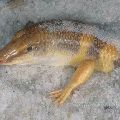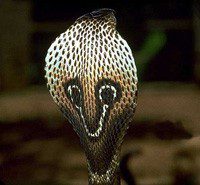
Currents
In the folklore of some peoples, the current gecko, settling in a new house, is a guarantee of happiness and prosperity, akin to our brownie. And his peculiar cry is a good sign, especially if he is heard on the day the baby is born. The cuckoo of Southeast Asia – so affectionately called the currents people. Unlike many other reptiles, this lizard is endowed by nature with a real voice. And even the species name of the reptile is rooted precisely in the characteristic sounds “currents” or “tokey” emitted by it. Based on them, a kind of game has even developed among the population of Southeast Asia – in it, bets are made on the number of calls that the toki gecko will reproduce at one time or another.
Contents
Classification
Kingdom: Animals
Type: Chord
Subtype: Vertebrates
Class: Reptiles
Order: Scaly
Suborder: Lizards
Family: Geckos (Gekkonidae)
Subfamily: Real • geckos – Gekkoninae
Genus: real • geckos – Gekko
Species: Gekko Gekko
Appearance
 Toki, like most geckos, are nocturnal lizards. Their males are much larger than females, their size is 30-35 cm, and they are also brightly colored. The back of the reptiles is gray, bluish, olive or dark green with terracotta and white patches, turning into stripes on the tail. For vision adapted to a nocturnal lifestyle, large eyes without moving eyelids with a vertical pupil expanding in the dark are responsible – their geckos periodically lick their tongue, washing. The toka’s body is quite dense, slightly flattened, the head is large, the paws are short, and the tail is of medium length. The ability of these lizards to move even on vertical surfaces is provided by scales on the bottom of the toes. On the scales are microscopic brushes of tiny hairs, which scientists were able to see using a 35000-fold magnification under a microscope. There are more than 200 million such brushes on one toki finger. Due to their small size, their hook-shaped hairs can cover any irregularities even on a surface that seems absolutely smooth to people. It seems that geckos have suction cups on their fingers. However, people have not yet been able to fully understand this mechanism.
Toki, like most geckos, are nocturnal lizards. Their males are much larger than females, their size is 30-35 cm, and they are also brightly colored. The back of the reptiles is gray, bluish, olive or dark green with terracotta and white patches, turning into stripes on the tail. For vision adapted to a nocturnal lifestyle, large eyes without moving eyelids with a vertical pupil expanding in the dark are responsible – their geckos periodically lick their tongue, washing. The toka’s body is quite dense, slightly flattened, the head is large, the paws are short, and the tail is of medium length. The ability of these lizards to move even on vertical surfaces is provided by scales on the bottom of the toes. On the scales are microscopic brushes of tiny hairs, which scientists were able to see using a 35000-fold magnification under a microscope. There are more than 200 million such brushes on one toki finger. Due to their small size, their hook-shaped hairs can cover any irregularities even on a surface that seems absolutely smooth to people. It seems that geckos have suction cups on their fingers. However, people have not yet been able to fully understand this mechanism.
Not so long ago, in the scientific world, they started talking about the possibility of distinguishing two subspecies of currents. One of them is the typical gecko described above, which lives throughout its range. And the other is found in southern China and northern Vietnam. It is a larger reptile, dark gray in color with slightly more muted orange spots. The back of a gecko can be full of white patches and black spots, especially contrasting in males. The eyes of these lizards are dark brown, while those of the typical subspecies are light. And most importantly, representatives of the second possible subspecies of geckos do not make any sounds, unlike typical toki.
Distribution and habitation
Currents live in Southeast Asia, in tropical rainforests, including mountainous ones, on rocky lowlands, and also near people. But if Asia is the original place of residence of the currents, then the gecko was introduced to some other countries. For example, currents can be found today in the southern United States, in states such as Florida. Not avoiding the proximity of humans, these lizards live in various residential buildings – outside the cities in palm huts and even in urban stone skyscrapers. You can sometimes see currents on the wall in the living room, where lizards prey on various insects, say, cockroaches. But these geckos always live alone.
Behavior and lifestyle
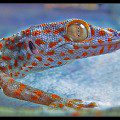 Currents give the deceptive impression of clumsy and slow reptiles. In fact, these lizards are surprisingly dexterous in moving around any objects – trees, rocks, walls of houses, and even absolutely smooth glass surfaces. Currents lead a twilight or nocturnal lifestyle, replacing diurnal reptiles with sunset. In the evenings, geckos prey on various insects attracted by electric light and because of this they are valued by people as useful creatures. Currents are even specially launched into new houses. However, the nature of these lizards is far from the most friendly. They are quite aggressive towards their relatives and do not let strangers into their territory, declaring their right to it with loud cries. And these geckos are capable of screaming for a long time, almost all night, but if something frightens them, then the screams immediately stop. By these sounds, geckos are found by hunters who catch lizards for food. The currents themselves during the hunt never go far from their homes. And their females are silent, so they become prey much less often. However, catching a gecko is not so easy. Tokas have strong jaws that are almost impossible to open without damage. There are cases when a snake that attacked the currents was in response tightly squeezed by the jaws of a gecko, and such a confrontation lasted more than 4 hours. So the currents are quite able to cling to some object stretched out by them and even hang on it, holding on only with their jaws. However, you can still catch a gecko. To do this, it is enough to sprinkle water on the surface on which he runs – the paws of the lizard lose their tenacity from moisture. Once in the hands, the gecko hisses loudly, swells up and opens its mouth wide, trying to attack the enemy. Toki is not at all like an affectionate and sweet creature, and if he does not like the treatment, then the gecko is able to bite painfully.
Currents give the deceptive impression of clumsy and slow reptiles. In fact, these lizards are surprisingly dexterous in moving around any objects – trees, rocks, walls of houses, and even absolutely smooth glass surfaces. Currents lead a twilight or nocturnal lifestyle, replacing diurnal reptiles with sunset. In the evenings, geckos prey on various insects attracted by electric light and because of this they are valued by people as useful creatures. Currents are even specially launched into new houses. However, the nature of these lizards is far from the most friendly. They are quite aggressive towards their relatives and do not let strangers into their territory, declaring their right to it with loud cries. And these geckos are capable of screaming for a long time, almost all night, but if something frightens them, then the screams immediately stop. By these sounds, geckos are found by hunters who catch lizards for food. The currents themselves during the hunt never go far from their homes. And their females are silent, so they become prey much less often. However, catching a gecko is not so easy. Tokas have strong jaws that are almost impossible to open without damage. There are cases when a snake that attacked the currents was in response tightly squeezed by the jaws of a gecko, and such a confrontation lasted more than 4 hours. So the currents are quite able to cling to some object stretched out by them and even hang on it, holding on only with their jaws. However, you can still catch a gecko. To do this, it is enough to sprinkle water on the surface on which he runs – the paws of the lizard lose their tenacity from moisture. Once in the hands, the gecko hisses loudly, swells up and opens its mouth wide, trying to attack the enemy. Toki is not at all like an affectionate and sweet creature, and if he does not like the treatment, then the gecko is able to bite painfully.
Food
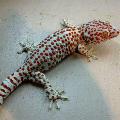 To provide geckos with currents of a suitable diet, herpetologists recommend breeding their food on their own. It can be flour worms, various cockroaches and crickets. In specialized nurseries, currents are fed with quail eggs and newborn rodents. Below are a few tips on how to make your Toki diet more nutritious. As for flour worms, they cannot be considered a particularly high-calorie food, and the hard chitinous covers of these larvae make digestion difficult and can lead to inflammation of the stomachs of lizards. Therefore, before feeding the worms, it is recommended to keep them on nutritious feed so that they gain weight. And in no case should flour worms be stored in damp rooms; containers with bran or oatmeal are better suited for this.
To provide geckos with currents of a suitable diet, herpetologists recommend breeding their food on their own. It can be flour worms, various cockroaches and crickets. In specialized nurseries, currents are fed with quail eggs and newborn rodents. Below are a few tips on how to make your Toki diet more nutritious. As for flour worms, they cannot be considered a particularly high-calorie food, and the hard chitinous covers of these larvae make digestion difficult and can lead to inflammation of the stomachs of lizards. Therefore, before feeding the worms, it is recommended to keep them on nutritious feed so that they gain weight. And in no case should flour worms be stored in damp rooms; containers with bran or oatmeal are better suited for this.
A more suitable delicacy for toki are crickets. These insects are somewhat softer and better digested. True, they are able to sing quite loudly, so it is better to place crickets in a place where their singing will not annoy others. Tokay gecko owners most often breed house crickets and spotted crickets under certain conditions as described in the relevant insect breeding literature.
And finally, another type of food for tokas is tropical marbled cockroaches. Don’t be put off by the fact that these insects are hard to come by. They can be replaced with the most common red Prussians. They, like crickets, are bred according to certain conditions of detention and kept in a special aquarium. So taking care of the power supply turns out to be quite troublesome. In nature, everything is much simpler. There, the gecko chooses suitable insects, and also catches small lizards, frogs, and even ruins bird nests with small eggs. This lizard does not drink water on purpose – it collects moisture by licking dew from plants, so it is not necessary to put a drinking bowl in the terrarium, it is enough to periodically spray it, creating an imitation of dew for the gecko.
Reproduction
 It will not be a discovery for anyone that toki geckos are oviparous. This feature is common to most lizards. In order to lay eggs, the female toki needs a shelter. In nature, this most often turns out to be a hollow or a gap in some structure. In the terrarium, for the female, special shelters are made from pieces of bark. Toki are extremely prolific, but this fecundity is expressed not in the number of eggs, but in year-round mating. During the year, except for the winter months, the female gecko is able to make 4-5 clutches with an interval of one and a half months. Clutch contains 1-2 eggs. Gecko toki sticks eggs in a special way to the walls of the nest, and it is almost impossible to peel them off without damaging them. The incubation period takes place at a temperature of 28-30 degrees and takes about 5 and a half months. An egg-laying female should be fed especially carefully, adding various calcified additives to her diet. And when the cubs hatch, the mother will eat the egg shells, which are also rich in calcium. The size of newborn currents is no more than a centimeter. Small geckos are brightly colored and move their striped tail very quickly – this scares off predators. However, parents are able to eat their offspring if the terrarium seems to them too cramped for the whole family. For example, there were cases when the male-producer from the appeared litter ate only males, thus eliminating possible competition. Of course, cannibalism in the Toki family does not always happen, but still it is recommended to separate young animals from adult geckos. Female toki laying is done mainly at night. Sometimes it is placed in an incubator, and sometimes left in a terrarium. There are also common clutches of several females in one nest. At the same time, the gecko mother never strays far from the nest, although it cannot be said that she is characterized by conscious care for her offspring. The currents that were born almost immediately begin to molt and eat the peeling skin.
It will not be a discovery for anyone that toki geckos are oviparous. This feature is common to most lizards. In order to lay eggs, the female toki needs a shelter. In nature, this most often turns out to be a hollow or a gap in some structure. In the terrarium, for the female, special shelters are made from pieces of bark. Toki are extremely prolific, but this fecundity is expressed not in the number of eggs, but in year-round mating. During the year, except for the winter months, the female gecko is able to make 4-5 clutches with an interval of one and a half months. Clutch contains 1-2 eggs. Gecko toki sticks eggs in a special way to the walls of the nest, and it is almost impossible to peel them off without damaging them. The incubation period takes place at a temperature of 28-30 degrees and takes about 5 and a half months. An egg-laying female should be fed especially carefully, adding various calcified additives to her diet. And when the cubs hatch, the mother will eat the egg shells, which are also rich in calcium. The size of newborn currents is no more than a centimeter. Small geckos are brightly colored and move their striped tail very quickly – this scares off predators. However, parents are able to eat their offspring if the terrarium seems to them too cramped for the whole family. For example, there were cases when the male-producer from the appeared litter ate only males, thus eliminating possible competition. Of course, cannibalism in the Toki family does not always happen, but still it is recommended to separate young animals from adult geckos. Female toki laying is done mainly at night. Sometimes it is placed in an incubator, and sometimes left in a terrarium. There are also common clutches of several females in one nest. At the same time, the gecko mother never strays far from the nest, although it cannot be said that she is characterized by conscious care for her offspring. The currents that were born almost immediately begin to molt and eat the peeling skin.
Interesting Facts
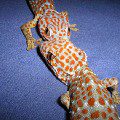 Toki geckos are considered useful to people not only as insect exterminators. Surprisingly, these lizards are still used in folk medicine in some Asian countries. In some local pharmacy you can easily find such a dried or live reptile, as well as buy a powder, ointment or tincture made from it. The healing properties of preparations from toki geckos are compared with the healing power of ginseng root. The diseases for which healers prescribe these drugs are completely different – overwork, cough, nervous disorders, pressure problems, etc. It’s hard to tell if the medicine actually helps. However, the locals respect him very much.
Toki geckos are considered useful to people not only as insect exterminators. Surprisingly, these lizards are still used in folk medicine in some Asian countries. In some local pharmacy you can easily find such a dried or live reptile, as well as buy a powder, ointment or tincture made from it. The healing properties of preparations from toki geckos are compared with the healing power of ginseng root. The diseases for which healers prescribe these drugs are completely different – overwork, cough, nervous disorders, pressure problems, etc. It’s hard to tell if the medicine actually helps. However, the locals respect him very much.
There are many legends about this lizard. One of them glorifies the reptile’s ability to cling to various surfaces with its paws. The legend says that the toki gecko participated in the capture of impregnable fortresses, climbing the fortress walls with a rope, along which the troops then climbed. Of course, the lizard is unlikely to be able to keep even one person on a rope – that’s why it is a legend. But light objects like a hat hold currents easily – and this feature of it was once repeatedly used by petty thieves in eastern countries. In an ordinary home terrarium, it is almost impossible to meet a toki gecko. This animal is extremely fastidious, and only an experienced breeder is able to provide him with decent care. It is with such owners that currents are most often found, since this gecko in nature gravitates towards human habitation. A group of geckos similar to toki are conventionally called house geckos. Living in the tropics, these reptiles settle in various human buildings. Therefore, they are often caught and sold to exotic lovers.
Sources of
http://iguana-kras.ru/
http://zoo.link.ua
http://aquaria2.ru/
http://www.apus.ru



